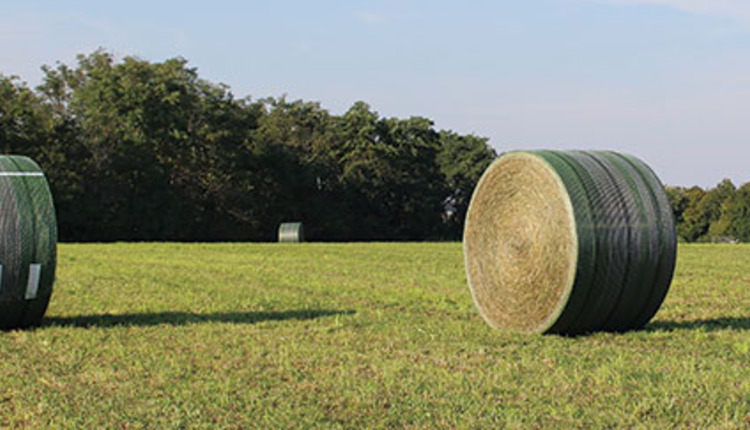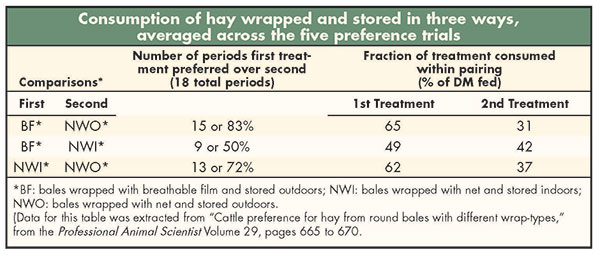Breathable film wrap improves hay consumption |
| By Kevin J. Shinners |
|
|
|
The author is a biological systems engineering professor with the University of Wisconsin-Madison.  Large round bales can be made for less cost than large square bales, and because the round bale shape helps shed precipitation, low-cost outdoor storage is possible. However, uncovered bales stored outdoors are subject to losses and deterioration of nutrient composition due to weathering. Additional losses can occur during feeding, mainly due to animal rejection of the weathered portion of the bale. Our research has shown that outdoor storage losses are less when bales are secured with net mesh rather than with twine. Wrapping with net mesh requires only three to five revolutions of the bale compared to 25 or more for twine. This difference improves productivity by reducing time lost to wrapping, and leaf loss is reduced as well. It’s the leaves that form the thatch that help shed water, so when leaves are lost during wrapping, more weathering losses occur during storage. Although uncommon, some producers wrap dry hay with a few layers of plastic stretch film using a bale wrapper. Bale conservation is improved because precipitation can’t reach the bale, but wrapping in film adds costs. Also, moisture often condenses at the interface between the bale and plastic, causing mold and algae growth. 
A new “breathable film” bale wrap known as “B-Wrap” has recently been introduced to overcome these deficiencies. The breathable film is applied at baling and is designed to not only shed precipitation, but allow water vapor to escape from the bale through microscopic pores. The ability for water vapor to escape eliminates the condensation problems associated with plastic film, and because the material is applied at the baler, the cost of wrapping dry hay with plastic film is eliminated. Our research has shown that bales wrapped with the breathable film reduced losses during storage. For instance, alfalfa bales stored for 10 months in Wisconsin experienced losses of 1 to 3 percent, 2 to 3 percent and 7 to 12 percent of dry matter for indoor, breathable film and net wrapped bales, respectively. Because net wrap and breathable film shed water so well, placing bales on a well-drained surface will reduce damage to the bottom of the bale (see figure). Preference trials A hay loss that is often overlooked occurs when animals refuse to eat weathered hay. We investigated how different ways to wrap alfalfa hay might affect refusal losses from beef animals. Bales of alfalfa were stored indoors, outdoors with net wrap or outdoors with breathable film wrap. Bales were stored for 10 months and then tub ground before feeding. We quantified hay preference by (a) the number of times one hay was preferred over another and (b) the amount of each hay that was consumed across the entire trial. Hay wrapped with breathable film was preferred over net wrapped hay stored outdoors in all five trials. Cattle chose to consume hay from bales with breathable film 15 times out of 18 or 83 percent of possible pairings, and they consumed almost twice as much of this hay when paired with outdoor stored hay (see table). Preference of hay from breathable film bales did not differ from that stored indoors. This study published in the Professional Animal Scientist showed that, when bales are stored outdoors, beef cattle strongly preferred hay conserved with breathable film compared to net wrapped hay, which might result in less hay lost to rejection at feeding.  Moisture profile (scale on right) of alfalfa bales stored outdoors for 10 months in Wisconsin. New wrapped bales stored on soil (left) or on a rock pad (middle); and bales wrapped with breathable film stored on a rock pad (right). There is no one right way to wrap and store round bales. Producers in arid climates baling grass hay that thatches well may find that twine wrap is an economical option. Breathable film costs an additional $5 per bale beyond net wrap, so it may not be the right choice for low quality hay or bales that will be consumed shortly after baling. But good-quality hay that will be stored outdoors for several months or longer can be wrapped with breathable film and benefit from better storage conservation, and potentially reduced feeding losses and improved animal intake that will help offset its added cost. • This article appeared in the August/September issue of Hay & Forage Grower on page 10 and 11. Not a subscriber? Click to get the print magazine. |
